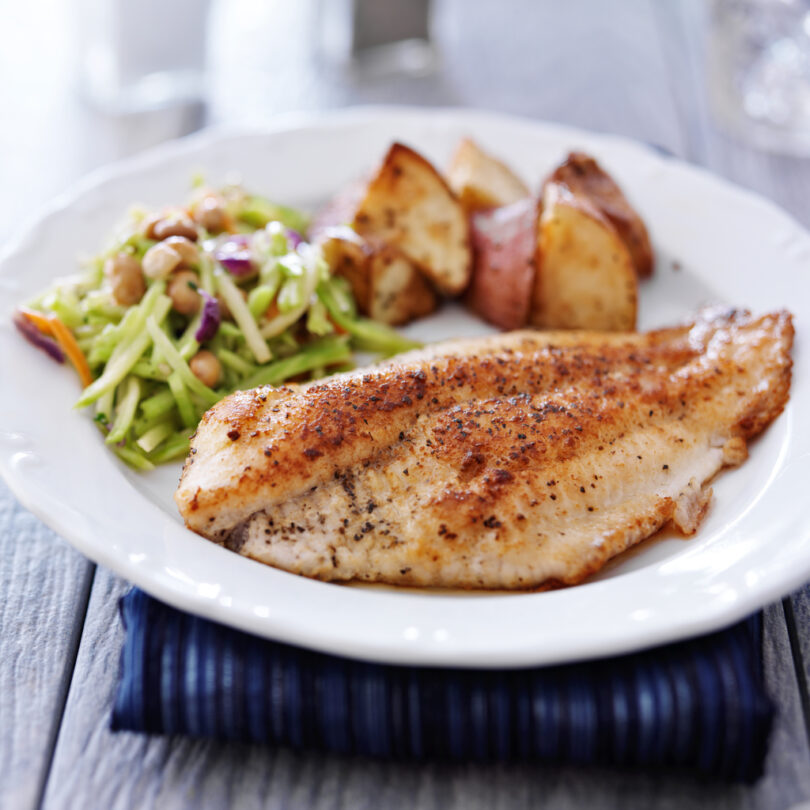It takes longer to tell the story about how blackened fish catapulted New Orleans onto the culinary world stage in the 1980s than it does to prepare the dish itself for a quick, nutritious, and delicious meal on a busy Tuesday night. Storied chef Paul Prudhomme introduced this dish to diners at his celebrated New Orleans haunt, K-Paul’s Louisiana Kitchen, combining the richness of a well-buttered, thin, redfish fillet with a spice mixture as spirited as a Mardi Gras krewe strutting in full regalia. The dish proved so popular that redfish, also known as red drum, was fished so heavily from the Gulf of Mexico that the species nearly disappeared from those coastal waters later that same decade. As redfish is now farmed, and thus still commercially available, the original dish endures. But the lightning-quick technique has evolved through time and is now applied to a variety of dishes, from center-of-the-plate stars like tuna and tilapia to chicken breasts and cauliflower steaks.
It’s called “blackened” because the method prescribes appropriately burning (or blackening) the spice coating. Dredging any fish fillet – like the Alaska pollock I use in my video — in a customized blend of herbs and spices before placing it in a blistering-hot cast iron pan to char adds a jolt of personality. This is an aromatic, read smoky, preparation. Good ventilation is key to controlling the sultry perfume of the blackening process. The high heat cooking process coaxes out and flatters the sweeter characteristics of most fish. Further, glistening the fish with a bit of fat once you’ve placed it on the hot pan, allows the spices to toast evenly, blooming their flavors, and adding a crisp texture. Prudhomme debuted the dish with butter as the fat of choice, but I tend to cut it with a more heart healthy option.
There are as many blackening spice recipes as types of seafood appropriate for the blackened technique. Whichever blend you choose to be the hero in your own blackening recipe will make the prospect of cooking any catch of the day both a familiar process and an exciting discovery. Blackening is a technique that helps cooks get more healthy seafood on the table more often.
Remember to take the pledge to eat #Seafood2xWk at seafoodnutrition.org/pledge.
Blackened Whitefish
Any white-flesh fish with relatively thin fillets like Alaskan pollock, Acadia redfish, catfish, croaker, perch, snapper, tilapia or weakfish would be perfect partners to the bold flavors of this spice blend, adapted from New Orleans Chef Paul Prudhomme’s original.
Serves 4
Ingredients
Kosher Salt
1 tablespoon sweet or smoked sweet paprika
1 tablespoon freshly cracked black pepper
1 teaspoon onion powder
1 teaspoon garlic powder or garlic salt
1 teaspoon dried, crushed oregano
1 teaspoon dried, crushed thyme or rosemary
Pinch of cayenne pepper
4, 5-ounce skin-on Alaska pollock
4 tablespoons (1/2 stick) unsalted butter, melted
4 tablespoons olive oil
1 cup loosely packed of fresh herb leaves (such as parsley, mint, chervil)
Lemon wedges for serving
Directions
Mix all spices and dried herbs in a wide, flat bowl. Lightly season fish with salt and let sit 20 minutes. Heat a large cast iron skillet or heavy-bottomed sauté pan over high heat until it is screaming hot. Combine butter and oil in a small bowl and dip each fillet so it barely glistens on all sides. Dredge each fillet in the spice mix, coating them evenly. Place coated fillets in the pan and drizzle about 1 teaspoon of the butter/oil mixture over each fillet. Cook fillets undisturbed for 2 minutes before turning them to cook for another 2-3 minutes. The spices will have formed a colorful crust ranging from sunset red to midnight black. The fish is done when it flakes apart under gentle pressure of your finger. Transfer fillets to serving plates, scatter with fresh herbs and garnish with lemon wedges.



Leave a Reply